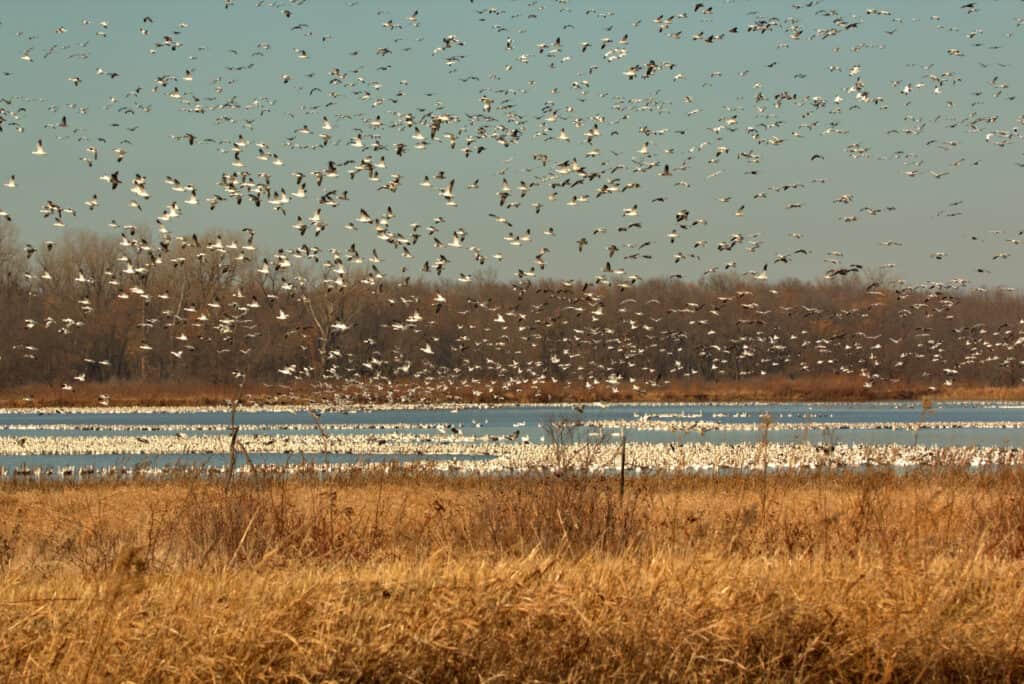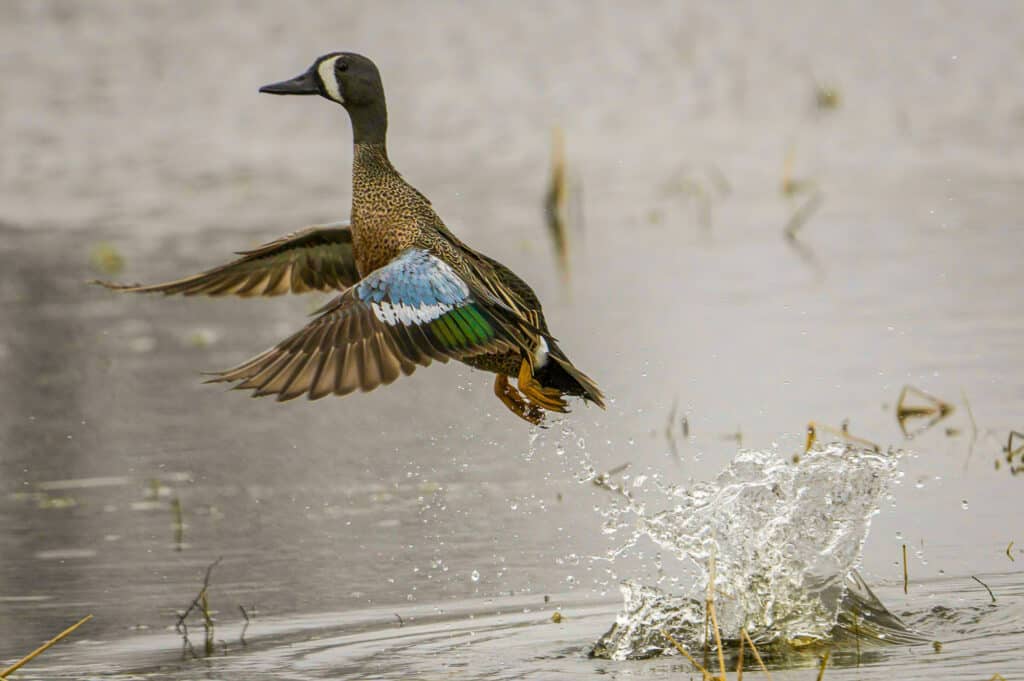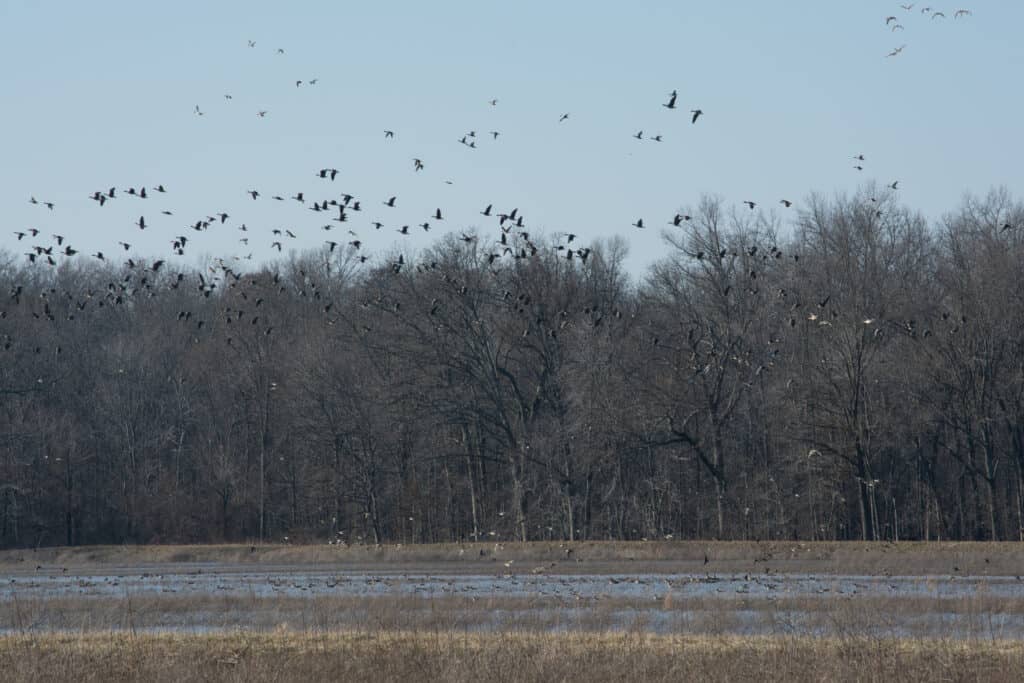Missouri, also known as the Show Me State, brings people in from all over the country. The vast nature and hometown feel of this midwest state are perfect for birders. There are plenty of incredible areas throughout the state for you to see warblers, shorebirds, waterfowl, bald eagles, and more.
Below you’ll find out the top ten spots for bird-watching in Missouri. Make sure you pack a pair of binoculars, sturdy hiking shoes, and a sense of adventure! Let’s take a look at what parks, conservations, and refuges made the list!
Squaw Creek National Wildlife Refuge
In the historic Missouri River floodplain in northwest Missouri, there is a place called Squaw Creek National Wildlife Refuge. For migrating birds and other species, the 7,350-acre refuge was constructed in 1935 as a resting, eating, and nesting area. The main draw of Squaw Creek is its dense populations of bald eagles, snow geese, and other waterfowl.
A key resting place for waterfowl, the refuge attracts more than 500,000 birds in the autumn and fewer but still impressive quantities in the spring. Within the Mississippi Flyway lies the sanctuary. Many animal species, including about 309 species of birds, use Squaw Creek because the refuge has a variety of habitats.

See Snow Geese By The Hundreds At Missouri’s National Wildlife Refuge
©ron99/Shutterstock.com
Swan Lake National Wildlife Refuge
Swan Lake National Wildlife Refuge is a fantastic site with marshes that are ideal for shorebirds and ducks who are wanting to feed and rest during the migratory season. It is situated in the center of North-central Missouri.
These birds travel great miles throughout their migration, but they frequently rest in these wetlands to take a break before continuing on to the next place. If you want to perhaps view more than 260 different bird species, including shorebirds, ducks, geese, and swans, this is an excellent place to visit in the Show Me state!

Swan Lake in Missouri Houses Ducks, Geese, Swans, and More
©iStock.com/Brian Reinke
Eagle Bluffs Conservation Area
Boone County is home to this magnificent conservation area, which is also close to McBain and situated in the southwest corner of Columbia. There are 17 wetland pools in the region, which provide 1100 acres of marshland, agricultural land, and rising marshes.
This creates the ideal habitat for birds who migrate and require a spot to stop along their route throughout the winter. Additionally, there are fantastic prospects for hunting, birding, and animal observation in this region. Don’t forget to go hiking or camping with your friends and
Even while this establishment isn’t really open 24 hours a day, 7 days a week, the present operating hours nevertheless offer you plenty of time to appreciate this lovely site. It’s open every day of the week from 4 AM to 10 PM, including weekends and holidays.

Eagle Bluffs Conservation area is 1,100 acres of marshes
©LanaG/Shutterstock.com
Riverlands Migratory Bird Sanctuary/Melvin Price Locks and Dam
The nearly nine miles of trails that make up the river lands region are one of its intriguing features, as they offer the ideal chance for birdwatchers and backpackers wishing to spend time in the outdoors. For anybody interested in watching their favorite avian animals in the wild, there are also bird blinds and observation posts accessible.
These routes will take you through environments such as bottomland forests, grasslands, and wetlands. These locations provide fantastic chances to see a wide range of birds as well as other alluring species.
Popular Birds Found Here:
- Trumpeter Swan
- Tundra Swan
- Lapland Longspur
- Bobolink
- Peregrine Falcon
- Short-Eared Owl
- Northern Bobwhite
- Grasshopper Sparrow
- Horned Lark
- Bald Eagle
- Northern Harrier
- Great Blue Heron

Trumpeter Swans Are Found At The Riverlands Migratory Sanctuary
©Danita Delimont/Shutterstock.com
August A. Busch Memorial Conservation Area
The 6,987-acre Busch Conservation Area also includes wetlands, ancient fields, grassland, crops, and 3,000 acres of woodland. The Busch Conservation Area’s lakes and ponds provide a lot more than just fishing possibilities. Rich feeding places and nesting boxes on the site draw a wide variety of wildlife that either calls it home or migrates through it. Along with shorebirds like sandpipers and blue herons, it’s possible to view waterfowl like geese.
Many other species of birds, such as dozens of songbirds, quail, hawks, owls, and the rare eagle, have access to tasty food supplies in other ecosystems. At refuge lake and along the Fallen Oak Trail, there are 5 viewing blinds, including 2 that are handicapped accessible. The Great Missouri Birding Trail includes the Busch Memorial Conservation Area.

Hawks Can Be Seen In The August A. Busch Conservation Area
©Vizz Effect/Shutterstock.com
Schell-Osage Conservation Area
The 8,600 acres that make up this great birding hotspot in west central Missouri are designated as a conservation reserve. Its abundance of productive habitats makes it the ideal location for birds and observers to interact and enjoy one another’s company. Lakes, ponds, farms, fields, woodlands, tall grass grasslands, and other natural features abound in the region.
Additionally, you’ll find a broad variety of species, including shorebirds, songbirds, and a total of over 270 bird species. Some of the most commonly spotted birds at the Schell-Osage Conservation Area are the Canada Goose, Prothonotary Warbler, and Bald Eagle.

The Schell-Osage area has 270 birds across 8,600 acres
©TommyBrison/Shutterstock.com
Taberville Prairie Conservation Area
A relic of the grassland ecosystem that once encompassed more than a fourth of Missouri is the Taberville Prairie. Additionally, it is home to flora and fauna that have been uniquely suited for existence on the wide open grassland.
A number of these species are becoming increasingly uncommon since less than 0.5 percent of the original grassland is still present in Missouri. Priority areas for management include providing habitat for bobwhite quail, greater prairie chickens, and grassland species like the upland sandpiper and Henslow’s sparrow to nest and raise their young.

The Taberville Grassland houses sanpipers and sparrows
©TommyBrison/Shutterstock.com
Mingo National Wildlife Refuge
The traditionally wooded bottomlands, swamps, and emergent marshes that make up the majority of the IBA on federal and state lands once covered the relatively level landscape. The Mingo Basin is a relic of bottomland forest, marshes, and marsh that is fully protected and offers excellent breeding and migratory marsh habitat.
Over the course of several years, these public landholdings have been home to at least three distinct, successful Bald Eagle nesting sites. These regions have also been home to Common Moorhen, Least Bittern, and other marsh species, some of which have breeding traces. In the IBA, Purple Gallinule has been spotted in this location.

The rare Purple Gallinule has been spotted at the Mingo National Refuge
©Brandon B/Shutterstock.com
Roaring River State Park
This stunning state park in the Missouri Ozarks is well-known for its natural spring, its fish hatchery, and its excellent trout fishing, but birders also recognize it as the home of a noteworthy variety of forest species. It is situated next to a section of the Mark Twain National Forest, seven miles south of Cassville.
The park is home to a number of highly sought-after warblers, and one location close to Camp Smokey has earned the name “Warbler Woods.” During your stay, you could see a variety of birds, including the Ovenbird, Worm-eating Warbler, Louisiana Waterthrush, Blue-winged Warbler, Black-and-white Warbler, Prothonotary Warbler, Kentucky Warbler, Common Yellowthroat, and more.

Warblers frequent the Roaring River State Park
©iStock.com/PaulReevesPhotography
Clarence Cannon National Wildlife Refuge
This refuge’s 2000+ acres are managed for the growth of wetlands plants. The terrain is flat and low. Floodwaters, snowmelt, and rain all move very slowly or not at all across the landscape. Sedges, rushes, and certain grasses are among the water-tolerant plants that may survive in the often moist soil.
Many people visit the refuge to see the more than 200 kinds of migratory birds that live there, notably bald eagles, ducks, shorebirds, and songbirds. Numerous birds reside in the refuge, including a pair of bald eagles and the king rail, an endangered species in Missouri.

Clarence Cannon National Refuge is Home to A Pair of Bald Eagles
©iStock.com/Binkmann
Up Next
Thank you for reading! Have some feedback for us? Contact the AZ Animals editorial team.








